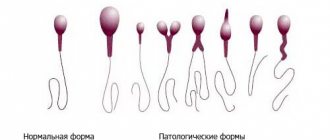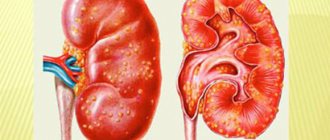Embolism prevention
There is currently no specific prevention of EOV.
Preventive measures are primarily related to the elimination of risk factors (preeclampsia, uteroplacental insufficiency, placental abruption) and the relief of chronic diseases. During pregnancy, uterine hypertonicity, which leads to increased pressure of the amniotic fluid, should be avoided. Highly qualified doctors and early diagnosis significantly reduce the risk of complications of EOV. Currently, there is no data that would show that if a woman has suffered this pathology, this will increase the likelihood of its occurrence in subsequent pregnancies.
None of my friends have encountered such a terrible condition as EOV. I read about such cases only in the news chronicle and on forums, where the unqualified or helpless doctors are most often discussed. It should be noted that high maternal mortality with such fulminant pathology is recorded not only in Russia, but also in European countries and the USA. In Israel, for example, two women die from EOV every year. The level of medicine in this country is considered one of the highest in the world. Despite this, only in 2020 were Israeli doctors able to save a woman in labor for the first time, whose heart stopped due to an embolism. At the beginning of 2020, specialists from the Obninsk maternity hospital also managed to save a woman with this pathology. But so far most cases end in death. I believe that this problem will not be solved until a way is found in which early specialized prevention can be carried out for every pregnant woman. Currently, EOV occurs quite rarely and occurs at lightning speed. Therefore, medical personnel in many situations are unprepared to provide immediate assistance. Studying this problem, I see that it is far from being resolved. Fortunately, EOV does not occur very often. But my wife admits to me that she was always afraid of such critical conditions during pregnancy, when practically nothing can be done.
Disease prevention
Pregnancy planning and preliminary preparation will help reduce the risk of developing pathology. A woman should treat existing pathologies before conception in order to avoid the development of unwanted reactions during pregnancy.
It is necessary to start seeing a gynecologist in a timely manner. You need to visit the doctor regularly: the doctor will be able to detect abnormalities in a timely manner and take measures to avoid the death of the woman and child.
All diagnostic tests must be completed in a timely manner.
Regular physical activity is recommended. Special physical therapy exercises for pregnant women should be performed every day for at least half an hour. You can exercise on a fitball, do breathing exercises, or walk. If the gynecologist allows it, swimming, water aerobics and other sports are allowed.
Important information: Chronic cerebrovascular insufficiency
You must follow a special diet. You should avoid spicy foods and foods fried in oil. It is better to give preference to natural products. The preferred heat treatment is boiling, steaming, stewing, and baking in the oven.
The level of nervous tension needs to be reduced. To do this, you should reduce communication with unpleasant people and avoid lack of sleep. If your job is associated with constant stress, it is better to change it, go on maternity leave, or quit. It is important to get enough rest. You need to sleep at least 8-9 hours every day.
Conditions leading to embolism should be prevented. It is necessary to promptly diagnose increased uterine tone and stop it. In addition, it is important to prevent the development of gestosis, placental insufficiency, preeclampsia, eclampsia and other pathologies.
Requires drinking plenty of fluids. Dehydration is unacceptable.
How does amniotic fluid embolism develop?
Normally, a pregnant woman's uterus contains 0.5-1.5 liters of amniotic fluid - a suspension containing both waste products of the fetus and secretion products of the placental membranes. Of the particles that make up the suspension, the most significant are lanugo, fetal lubricant, epithelial scales, meconium with bile pigments, intestinal mucin and trophoblasts. In the liquid part, amniotic fluid contains a huge amount of biologically active substances: arachidonic acid, thromboplastin, tissue factor III, leukotrienes C4 and D4, interleukin-1, TNF, thromboxane A2, phospholipase A2, prostaglandins, profibrinolysin, endothelium, collagen and surfactant. In addition, amniotic fluid contains proteins, fats, lipids, carbohydrates, potassium, calcium, sodium, trace elements, urea, hormones (folliculin, gonadotropic hormone, etc.), lysozyme, lactic and other acids, enzymes, substances that promote uterine contractions (oxytocin ), group antibodies corresponding to the fetal blood type.
Amniotic fluid embolism can manifest itself even in the early postpartum period - the development of the clinical picture of EOV has been reported 10-20 and even 32 hours after childbirth and cesarean section. In addition, the severity of clinical manifestations often does not correspond to the degree of pulmonary vascular damage. In this regard, it is currently customary to associate the clinical manifestations of EOV with the development of a severe systemic anaphylactoid reaction in response to the entry of biologically active substances of amniotic fluid into the maternal bloodstream. With intrauterine infection of the fetus, the amniotic fluid can become infected, and its entry into the maternal bloodstream causes an even more severe anaphylactoid reaction. The entry into the maternal bloodstream with amniotic fluid of a significant amount of the biologically active substances listed above causes degranulation of mast cells, the release of histamine and endothelin, leukotrienes and FIO. Such a powerful mediator explosion can lead to the development of bronchospasm, pulmonary vasospasm, right ventricular failure, and then left ventricular failure with the development of OA and shock of mixed origin. In particularly severe cases, cardiac arrest has been described.
1-1.5 hours after an episode of EOV, acute coagulopathy occurs with massive bleeding, which is associated with the supply of tissue thromboplastin and the action of mediators. The clinical picture follows the scenario of fulminant DIC with poorly controlled massive bleeding, accompanied by critical blood loss resulting in MOF syndrome.
As mentioned above, amniotic fluid embolism is characterized by massive profuse bleeding caused by severe disseminated intravascular coagulation syndrome with hypofibrinogenemia, thrombocytopenia, sharply activated fibrinolysis and depletion of all blood coagulation factors. In the development of thrombohemorrhagic complications associated with EOV, the main role is played by the amount of amniotic fluid entering the maternal bloodstream, as well as the degree of the woman’s immune reactivity.
DIC syndrome with amniotic fluid embolism occurs in two stages - a very short-term stage of hypercoagulation and a stage of hypocoagulation and deficiency of coagulation factors. The hypercoagulation phase is caused by tissue thromboplastin entering the maternal bloodstream along with the amniotic fluid, which triggers the external coagulation mechanism. This phase is rapid in nature and is extremely rarely detected in the laboratory.
Along with thromboplastin, amniotic fluid contains a factor that accelerates the retraction of a blood clot. As a result of consumption, depletion of coagulation factors and thrombocytopenia occurs. Fibrinolysis is activated and the process enters the hypocoagulation stage, characterized by massive bleeding. According to various sources, fetal death with a pronounced clinical picture of EOV during childbirth ranges from 50 to 80%. Of these, the majority (90%) die intranatally. The main cause of death is intrauterine asphyxia.
The mechanism of pathology development
Amniotic fluid contains more than just water. A large number of biologically active substances are dissolved in it. Hormones, various peptides, carbohydrates, lipids, and fetal urine are present. Skin flakes, meconium and cheese-like lubricant are detected. Normally they do not come into contact with the mother's blood. But with amniotic fluid embolism, a complex pathological process is triggered. Amniotic fluid is delivered to the pulmonary artery, small veins and alveoli of the lungs. The histamine contained in the liquid enhances the response.
There are two phases of pathology:
- Initial phase. This triggers an anaphylactic reaction, releasing biologically active substances that cause spasm of the bronchi, pulmonary vessels, swelling, shock and ventricular heart failure.
- Progressive phase. Under the influence of mediators, a large amount of thromboplastin is released, blood clotting is disrupted, and coagulopathy occurs with massive bleeding.
Each phase has its own clinical signs. They are more pronounced when a large volume of amniotic fluid enters the vascular bed.
Causes of embolism in increased intrauterine pressure
What is meant by amniotic fluid embolism?
At risk are pregnant women and women in labor
The condition is a complication during childbirth, or less commonly during pregnancy; and with it, amniotic fluid is sucked into the blood vessels. A disorder develops if the pressure inside the uterus rises sharply and exceeds that in the veins. As a result, if there are damaged vessels, water easily penetrates into them. In response to this, the process of blood clotting disorder is started, in which multiple blood clots form in the vessels in a short time, and at the same time, bleeding develops.
In most cases, the complication appears in the first or second stage of the birth process. To a much lesser extent, water embolism occurs in the second or third trimester and the postpartum period. Most women experiencing disorders are multiparous.
How is EOV diagnosed?
The truly frightening aspect of amniotic fluid embolism is that there are no early signs that could signal its development, and there is no prevention or treatment for this complication. There are no tests that could indicate the development of EOV, so doctors rely on the following symptoms:
- Severe shortness of breath;
- Low oxygen levels in the blood;
- Choking, coughing;
- Sudden severe chest pain;
- Turning blue;
- Sudden drop in blood pressure or cardiac arrest.
- Bleeding from various parts of the body.
If all of the above symptoms occur during labor, cesarean section, dilatation, or other surgical intervention during childbirth, and when these symptoms appear within 30 minutes after birth, doctors diagnose amniotic fluid embolism.
Treatment
Treatment of embolism with amniotic fluid is aimed at restoring normal functioning of the heart and respiratory system, as well as stopping bleeding, and normalizing the condition of vital organs. Basically, drug therapy is used for this, which is combined with therapeutic treatment.
Emergency care for amniotic fluid embolism
Emergency care begins with an urgent call to an obstetrician and anesthesiologist. In the next few minutes:
- place the patient on a flat surface;
- free her from tight clothes;
- give her oxygen;
- fluid is quickly administered intravenously, preferably reopolyglucin;
- antispasmodics are administered;
During these actions, it is also necessary to prepare the drugs available in the pack for first aid for OV embolism.
Therapeutic method
To treat amniotic fluid embolism, intensive therapy is used, which is carried out in the intensive care unit. The mother may be given a blood transfusion to replace blood loss, as well as mechanical ventilation if the woman is unable to breathe on her own.
Medication method
The main drugs used for embolism are:
- Glucocorticosteroid hormones that help restore normal functioning of the cardiovascular system.
- Fibrinolysis inhibitors that stop bleeding.
- Indirect anticoagulants that prevent thrombosis.
- Aqueous and colloidal solutions (a.c.), which increase blood pressure.
- Blood thinners.
Other groups of drugs can also be used, for example, for early delivery. Much depends on the condition of the patient herself.
Operation
If an embolism is diagnosed in a woman giving birth, then early delivery should be carried out immediately after emergency care. This can be done by caesarean section or induction. This is the only chance to save the fetus.
If uterine bleeding caused by embolism cannot be stopped, the woman is advised to have the uterus removed. Other operations, if used, are extremely rare.
There are some recommendations against amniotic fluid embolism, and we’ll talk about them.
Diagnostic criteria and methods of therapy
Amniotic fluid embolism is a clinical diagnosis made by exclusion. Laboratory diagnostics or instrumental studies are not used, since the condition requires emergency care, and time counts in minutes. Clinical criteria for embolism are:
- acute hypotension with pressure less than 90/40 mmHg;
- shock or cardiac arrest;
- acute hypoxia of the pregnant woman, which can be combined with fetal hypoxia;
- coagulopathy, disseminated intravascular coagulation syndrome or massive bleeding, if there are no other causes of pathology.
If an accurate diagnosis cannot be established, transesophageal echocardiography, ECG, and hemostasis testing are performed.
In the acute period, correction of the shock state is necessary. Treatment is carried out with the following drugs:
- crystalloids – starting solution for correcting circulating blood volume and electrolyte balance;
- synthetic drugs - hydroxyethyl starch or modified gelatin;
- albumen;
- plasma substitutes.
If intravenous infusions at maximum speed are ineffective, vasopressor drugs are used for treatment, which increase the tone of the vascular wall and raise blood pressure. The most commonly used are Norepinephrine, Dopamine, and Adrenaline. In case of cardiac arrest, pulmonary-cardiac resuscitation is performed, including chest compressions, oxygenation, and, if necessary, defibrillation. It may be necessary to transfer the pregnant or parturient woman to artificial ventilation.
Treatment
Treatment goals: emergency care.
Treatment tactics When the first symptoms of amniotic embolism appear (chills, fever) or when amniotic embolism is suspected: First-line measures: 1. Oxygen therapy (provide humidified oxygen at a rate of 6-8 liters per minute). 2. Catheterization of two to three veins (central vein - after correction of hypocoagulation, preferably jugular). 3. Bladder catheterization. 4. Set up the operating room. 5. Simultaneously administer 420 – 480 mg of prednisolone intravenously. 6. Transfer the patient to the operating room for observation! 7. 20 minutes after the first dose - 180 - 240 mg of prednisolone IV.
Timely first-line measures stop the anaphylactic reaction and prevent the development of coagulopathic complications.
Obstetric tactics for relieving signs of EOM and stabilizing the condition of the pregnant woman is to conduct the birth through the natural birth canal under continuous monitoring of the condition of the woman in labor and the fetus.
Obstetric tactics for coagulopathic complications of amniotic fluid embolism include immediate surgical delivery and careful surgical hemostasis; expansion of the operation and ligation of the iliac arteries cannot be ruled out.
The next day after delivery - 30 mg of prednisolone 4 times a day intravenously. The next day, 30 mg of prednisolone intravenously once.
Anesthetic tactics for coagulopathic complications: - general anesthesia only; — massive infusion and transfusion therapy; — drug correction of coagulopathic disorders; — antibacterial therapy; — cardiac therapy; — extended mechanical ventilation; — control of diuresis; — control of central venous pressure; - prevention of multiple organ failure.
Drug therapy for complications of amniotic fluid embolism: - Emergency transfusion of fresh frozen plasma - up to 20 - 25 ml/kg, but not less than 800 ml. — Crystalloids (Ringer's solution, saline solution) infusion therapy up to 300% of the expected volume of blood loss with 100% replacement with erythrocyte-containing agents. — Plasma substitutes (6% hydroxyethyl starch), succinylated gelatin. — Red blood cell mass is 100% of the volume of blood loss. — If there is no rise in blood pressure during the infusion, connect vasopressors: dopamine 5 - 10 mg/kg per minute micro-jet (dispenser) ephedrine, phenylephrine. Maintain blood pressure at 100 – 110/70 mmHg. — Protease inhibitors: aprotinin preparations (under the control of fibrinolytic activity). — Tranexamic acid (250 – 500 mg IV). — Antihistamines — The most modern, effective and radical means of correcting coagulopathic disorders is the simultaneous administration of eptacog alfa (activated) (recombinant blood coagulation factor VIIa) at a dose of 90 mcg/kg.
Further treatment tactics: - antibacterial therapy - IV generation cephalosporins, beta-lactam antibacterial drugs; — cardiac therapy is carried out in accordance with the clinical situation; - prolonged mechanical ventilation until hemoglobin is restored to the level of 65 - 70 g/l, platelet count is at least 100 * 10 9/l, until stable restoration of hemodynamic parameters; — prevention of multiple organ failure until the symptoms of hypocoagulation disappear; antiplatelet agents only after eliminating coagulopathic bleeding.
Indicators of treatment effectiveness: prevent maternal mortality.
Types of embolism
The following forms of amniotic fluid embolism are distinguished:
- Forms of embolism:
- collaptoid
- hemorrhagic
- convulsive
- edematous
- lightning fast
The fulminant form is characterized by a very rapid malignant course.
Diagnosis is based primarily on the clinical picture, on the analysis of the obstetric pathology that developed in the patient. It is possible to conduct additional research if the woman’s condition allows it. Electrocardiography gives a picture reminiscent of myocardial infarction, chest x-ray reveals pulmonary edema, coagulogram determines the presence of disseminated intravascular coagulation syndrome.
Treatment of embolism with amniotic fluid should begin as early as possible - only this determines a favorable prognosis. The main principle of treatment is as follows: immediate and urgent delivery is necessary. Depending on the obstetric situation, the method that will make delivery as fast as possible is used here.
If the cervix is completely open, then obstetric forceps are applied; if the cervix is closed or not fully open, a cesarean section is performed. Emergency resuscitation measures are simultaneously performed to combat acute pulmonary heart failure and coagulopathy. Without emergency assistance, the woman is not transportable.
- The emergency algorithm can be briefly described as follows:
- combating pulmonary edema
- combating coagulation disorders
The woman in labor is given a sitting or semi-sitting position, oxygen is given (oxygen therapy through nasal catheters), and the oxygen must be humidified through ethyl alcohol. In the absence of spontaneous breathing, artificial ventilation of the lungs is carried out, the veins are punctured; during EVL, doctors try to clear the bronchi of contents, that is, they aspirate the contents of the bronchi, in order to expand the bronchi, atropine is injected intravenously, thereby reducing pulmonary edema.
Antispasmodics (“No-spa”), “Novocaine” (20-30 milliliters) are administered intravenously to reduce pulmonary hypertension, “Eufillin” to combat pulmonary edema, “Promedol”, Droperidol”, “Heparin” in the amount of 5000 units (with absence of coagulopathic bleeding) to prevent the development of DIC syndrome.
In addition, Refortan, glucose, insulin, cardiac analeptics and glycosides are used to treat heart failure. Corticosteroids (Prednisolone or Hydrocortisone in the amount of 300-1000 milligrams) are used as anti-anaphylactic agents to combat shock. In case of hypofibrinogenemic bleeding, hysterectomy, transfusion of fresh frozen plasma, red blood cells, fibrinogen and platelet mass.
Etiology
The causes of amniotic fluid embolism are unknown. About 40% of patients had some allergic diseases in the past.
Risk factors:
- mother's age over 39 years;
- C-section;
- multiple births;
- placenta previa;
- rupture of the uterus or cervix;
- weakness of ancestral forces;
- male fetus;
- rapid progress of labor;
- chorioamnionitis;
- large fruit;
- intrauterine fetal death.
The risk of developing embolism is 25 times higher in women with cerebral vascular diseases and 70 times higher in patients with heart disease. An association has been found between this condition and chronic kidney disease, placental abruption and eclampsia, as well as procedures such as amnioinfusion (injecting drugs into the amniotic sac), dilatation (artificial dilatation of the cervix) and curettage of the uterine cavity. It is believed that stimulation of labor with oxytocin does not lead to an increased risk of pathology.
How does embolism manifest?
Symptoms of amniotic fluid embolism may occur during pregnancy, childbirth, cesarean section, or within 12 hours of a normal birth. Signs of pathology develop rapidly, but with a small amount of amniotic fluid they can be erased. In this case, the woman feels:
- chills;
- general weakness;
- chest pain;
- shortness of breath.
Dizziness appears and blood pressure decreases. The skin and mucous membranes look pale, uterine bleeding increases or appears.
In severe cases of pathology, the symptoms are more pronounced. Blood pressure drops rapidly, it becomes less than 90/40 mm Hg. Art., in some cases the lower limit is not determined. Circulatory shock occurs, body cells suffer from hypoxia, which leads to the accumulation of lactate and the development of a state of acidosis.
Mental state disorders can have different severity, from mild dysphoria to deep depression of consciousness. This is due to oxygen starvation of the brain.
Convulsions may appear against the background of clouding of consciousness and sudden severe shortness of breath. Already at this stage, emergency assistance should be provided. The woman's nasolabial triangle and hands turn blue, and later cyanosis spreads to the whole body. Shortness of breath may be accompanied by a cough, which indicates the progression of pulmonary edema.
Maternal hypoxia affects the condition of the fetus if the embolism develops before the birth of the child. He also does not receive the necessary oxygen, and bradycardia develops. The condition is dangerous when the number of heart beats per minute is less than 100. The terminal condition of the fetus is indicated by bradycardia with a heart rate of less than 60, which persists for 3-5 minutes.
During a caesarean section, water can enter the veins of the uterus.
In this state, the uterus stops contracting and atony occurs. When embolism develops during childbirth or the postpartum period, massive bleeding occurs, leading to the consumption of blood clotting factors. Complications such as disseminated intravascular coagulation and hemorrhagic shock develop. Death occurs after cardiac arrest, which develops as a result of acute pulmonary hypertension and right ventricular failure.
Why does amniotic fluid embolism occur?
Hypovolemia
One of the reasons for the development of amniotic embolism is hypovolemia - a decrease in the volume of circulating blood. As a result, the pressure in the vascular bed decreases sharply, while the hydrostatic pressure in the uterine cavity remains at a normal level. Due to the difference in pressure gradient, a “suction” phenomenon occurs - amniotic fluid rushes into the vascular bed of the mother’s body.
Most often, hypovolemia occurs as a result of significant blood loss - the most common obstetric complication. In addition, a deficiency in the volume of circulating blood is observed during gestosis, when fluid goes into the tissues, causing swelling, with inadequate intake of diuretics or vasodilators.
High intrauterine pressure
The second reason why reflux of amniotic fluid into the maternal bloodstream may occur is high hydrostatic pressure in the uterine cavity. An increase in intrauterine pressure is typical for polyhydramnios, multiple pregnancies, incoordination of labor, rapid labor, and delayed amniotomy (opening of the amniotic sac).
An important condition for the implementation of amniotic embolism is the presence of damaged, gaping blood vessels through which amniotic fluid can enter the mother’s bloodstream in three ways:
- transplacentrano - through damaged arteries and veins of placental tissue as a result of premature abruption of a normally or low-lying placenta; manual separation of placenta; intraoperatively, when the incision is made on the placental tissue; in the presence of defects in the placenta (developmental disorders); after amniocentesis - puncture of the amniotic membrane;
- transcervical - through injured vessels in the cervix;
- transmural - through an injured area of the uterine wall, as a result of uterine rupture or during a cesarean section.
What are the risk factors?
A review of evidence-based studies found that there are a number of factors associated with an increased risk of amniotic fluid embolism:
- Pregnancy over 35 years of age;
- Placenta previa (if the placenta covers the cervix);
- Placental abruption;
- Induction of labor;
- Surgical interventions during childbirth, including caesarean section, use of obstetric forceps or vacuum;
- Cervical rupture;
While this complication cannot be prevented, it is worth understanding that it occurs extremely rarely: amniotic fluid embolism occurs in only 1 in 80,000 pregnant women.
Prevention
Preventative measures include the following:
- taking anticoagulants;
- constant monitoring of blood clotting indicators;
- timely detection and treatment of heart disease;
- preparation for surgery, including compliance with all doctor’s recommendations;
- lack of serious physical activity and stress
- accurate and precise treatment of wounds;
- compliance with the procedure for performing intravenous injections;
- eliminating problems with veins;
- injury prevention.
Most often, vascular surgeons are forced to deal with the manifestations of embolism. But representatives of general surgery, cardiology, traumatology and gynecology also take part in treatment and provide first aid to victims.
Sometimes it is possible to dissolve or surgically remove the intravascular embolus completely and thus restore oxygen saturation of tissues and organs.
But in difficult cases and with untimely diagnosis or incorrectly chosen treatment, tissue death occurs - necrosis or infarction of the organ occurs.
The most serious outcome of embolism during a heart attack in vital human organs is death.
The video talks about the pathogenesis of the formation of pulmonary embolism (PE)
Complications and prognosis
The likelihood of developing an embolism is only 5-8 cases per 100,000 births. Following your doctor's recommendations helps reduce the likelihood of a dangerous complication.
The outcome depends on how severe the pregnant woman’s condition was and how quickly measures were taken. Most often, the pathology ends in death for both the woman and the child. In the fulminant form, amniotic fluid embolism with a probability of up to 80% results in death in the mother and fetus. Other types of deviation have a greater number of favorable outcomes, and the risk of death is reduced. Positive completion of the pathology is possible only with the rapid initiation of medical procedures.
If mother and baby survive, complications often develop. A woman often experiences kidney failure and the blood supply to the brain is disrupted. After childbirth, inflammatory processes and purulent formations may appear.
Symptoms
Clinical manifestations develop most often in the first or second stages of labor or less often in the afterbirth and early postpartum period. Usually, against the backdrop of violent contractions, against the backdrop of seemingly external well-being, a picture of acute cardiovascular failure suddenly develops: cyanosis of the face and limbs, chills, shortness of breath, a feeling of fear of death, chest pain, epigastric pain, headache, high temperature. The objective condition of the woman is severe, the woman behaves restlessly, rushes about, breaks out in a cold sweat, suffocation increases, blood pressure drops to 60-40 per 0 millimeters of mercury, and in some cases is not determined at all. The pulse is about 110-120 or more beats per minute. Breathing is rare, rapid and always shallow. A collaptoid state often develops.
Amniotic fluid embolism is a very serious obstetric pathology.
Due to increasing brain hypoxia, seizures may appear, first clonic seizures and then tonic seizures, which is a very unfavorable prognostic sign. Loss of consciousness occurs and a coma develops. In parallel with all these symptoms (and this develops at lightning speed, literally in a few minutes), pulmonary edema develops, breathing becomes noisy, a cough is often associated with the discharge of foamy sputum, cyanosis increases, a lot of moist rales are heard in the lungs, in addition, clinical manifestations of acute right ventricular failure appear , the boundaries of the heart expand to the right and a gallop rhythm is heard, the accent of the second tone is on the pulmonary artery, and within literally a few minutes (sometimes, if it is a chronic embolism, this can happen within one to two hours), the woman dies from pulmonary heart failure. If doctors manage to stop the first phase, then the woman remains alive, then coagulopathic bleeding develops. In cases where amniotic fluid embolism develops during a cesarean section, all these symptoms of the first phase of pulmonary heart failure are observed by doctors, since the patient is under general anesthesia, but after the operation, bleeding of non-coagulating blood is detected, that is, coagulopathic bleeding develops .
Diagnostics
Since the embolism begins suddenly, it is difficult to trace the prerequisites for its occurrence in advance. Diagnosis and treatment are possible only when the first symptoms appear.
The doctor makes the primary diagnosis based on the observed symptoms. First, breathing is assessed: if it becomes confused, shortness of breath appears, quickly disappearing single dry wheezing can be observed, an embolism can be suspected. The doctor should check your pulse and measure your blood pressure.
After this, the mother will have to give blood samples for analysis. It is necessary to evaluate the number of platelets and fibrinogen. Then the coagulation rate of whole blood and APTT, which is an indicator of the coagulation of biological fluid, are examined.
The third stage is examinations using medical equipment. An electrocardiogram and an x-ray of the lungs are performed.
Important information: How to treat chronic idiopathic myelofibrosis and its symptoms
After this, the specialist assesses the condition of the fetus and selects appropriate methods of therapy.
Causes
The main reason for the development of amniotic fluid embolism is the entry of amniotic fluid (amniotic fluid) into the mother's bloodstream. This occurs due to the difference between intrauterine pressure (higher) and pressure in the mother's venous vessels (lower).
Increased intrauterine pressure is caused by:
- polyhydramnios (large volume of amniotic fluid);
- multiple pregnancy (presence of more than one fetus in the uterus);
- breech presentation of the fetus (position of the fetus with the pelvic end down to the internal opening of the cervix);
- large fruit (fruit weight more than 4000 grams);
- anomalies of labor:
- excessively violent labor (contractions are strong, frequent);
- incoordination of labor (contractions are strong, but do not lead to sufficient dilation of the cervix and movement of the fetus along the birth canal);
irrational stimulation of labor (inadequate use of uterotonics (drugs that stimulate uterine contractions)); cervical rigidity (the cervix is dense and difficult to stretch).
A factor contributing to a decrease in venous pressure in the mother is hypovolemia (dehydration, insufficient amount of fluid in the vascular bed) against the background of such maternal diseases as:
- heart defects (disorders of the structure of the heart);
- diabetes mellitus (increased blood sugar levels due to a lack or improper functioning of insulin, a pancreatic hormone);
- gestosis (a complication of pregnancy with increased blood pressure and impaired renal function).
Penetration of amniotic fluid into the maternal bloodstream is also possible when:
- untimely opening of the amniotic sac (after full dilatation of the cervix);
- premature abruption of a normally located placenta (the placenta separates from the wall of the uterus before the baby is born);
- placenta previa (the placenta is located low in the uterine cavity and covers the internal os of the cervix (exit from the uterine cavity));
- uterine rupture (violation of the integrity of the tissues of the uterine wall);
- cervical rupture (violation of the integrity of the tissue of the cervix);
- caesarean section (operative delivery).
An obstetrician-gynecologist will help in treating the disease
Water breaks during caesarean section: what does it mean, reasons
If your water breaks during a scheduled cesarean section, the reasons for this may be:
- premature onset of labor;
- incompetence of the cervix - it is not dilated and is small in size.
The rupture of amniotic fluid does not pose any danger; the woman will simply undergo emergency surgery.
https://www.youtube.com/watch?v=aKsp-LaWk28
If the waters break and a caesarean section was not planned, then this simply means the beginning of labor - you need to immediately go to the maternity hospital and strictly follow the doctors’ instructions. If there is no labor activity, or a control ultrasound examination of the fetus shows the impossibility of normal childbirth in a natural way, then the woman will undergo emergency surgery.
During a caesarean section, the amniotic fluid drains either naturally or after puncturing the bladder - the doctor can do this before administering anesthesia or after an injection in case of a planned intervention. It is highly desirable that the process occurs before the uterine incision, because this will help avoid amniotic fluid embolism.
What is amniotic fluid embolism in a woman in labor?
Embolism is a rather dangerous pathology. In some cases, it even leads to death for both mother and child. This disease has another name - thromboembolism.
Embolism often occurs in women who have previously given birth. In this case, swelling of the placenta itself may also appear. Typically, embolism (thrombosis) occurs during childbirth. Only in some cases was the disease noted in the early postpartum period.
Symptoms of the disease:
You can suspect the appearance of an embolism during the birth of a child due to a lack of oxygen in the woman in labor. When the vessels of the lungs are filled with amniotic particles, alveolar edema is formed, as a result of which the functionality of gas exchange is disrupted and hypoxia appears.
This may be accompanied by shortness of breath, rapid breathing, and attacks of suffocation. The woman in labor begins to cough for no particular reason. With a cough, foam and bloody sputum begin to appear.
Embolism OV
All these symptoms may be accompanied by severe pain in the abdomen and chest. The skin turns pale, peripheral cyonosis appears on it, sometimes cramps and swelling of the soft muscle tissue.
Further development of the disease can cause uterine bleeding and pinpoint hemorrhage of the epidermis. Very often, blood pressure drops sharply, the woman loses consciousness, her breathing and heart stop.
Embolism can be of several types:
- Collaptoid. During such an embolism, the cardiovascular system is disrupted, for example, blood pressure decreases, and the woman may lose consciousness.
- Convulsive. Rhythmic contractions of muscle tissue appear, which alternate with its relaxation.
- Hemorrhagic. Accompanied by bleeding from the uterine cavity and nose.
- Edema. During this embolism, fluid accumulates in the lungs, preventing oxygen from entering the bloodstream.
- Lightning fast. The disease progresses very quickly, during this period the functionality of all organs is disrupted.
Embolism has different forms.
The most severe form of the disease is fulminant. This is what can lead to death.
Varieties and symptoms
Embolism can be recognized by a number of symptoms. The skin color becomes pale and cold sweat occurs. Chills occur. A cough appears, quickly turning from dry to wet. Breathing is rapid and shallow. Pain occurs behind the sternum, in the upper abdomen. Soreness is noted in the extremities. Headaches are common.
There is a cyanosis of the lips, face, and limbs. Often a woman experiences severe anxiety, an irrational feeling of fear. Blood pressure decreases greatly, the pulse becomes frequent and difficult to palpate. There are convulsions and severe bleeding. Possible loss of consciousness.
Important information: Causes and treatment of blood eosinophilia in adults
Symptoms often appear partially. Features depend on how much amniotic fluid has penetrated the circulatory system.
Collaptoid form
Collaptoid embolism by amniotic fluid is characterized by abnormalities in the functioning of the cardiovascular system. Blood pressure drops significantly, pulse quickens. The limbs turn pale and are cold when touched. Fainting is common. Cardiac shock is severe.
Convulsive form
The characteristic symptoms of this type are uncontrolled muscle contractions. During attacks, breathing disturbances are observed, weakness, dizziness, and nausea are noted.
Hemorrhagic form
Characterized by heavy bleeding. Biological fluid quickly flows out of the body through the nose, eyes, and vagina. When punctures are taken and catheters are installed, blood begins to flow from the puncture sites.
Edema form
With this type of thromboembolism, amniotic fluid causes swelling of the lung tissue, leading to acute respiratory failure. Breathing is noisy, accompanied by the discharge of foamy sputum. Shortness of breath, coughing, and severe suffocation occur. A characteristic feeling of fear. Intense pain is noted in the sternum area. If medical attention is not provided in a timely manner, respiratory arrest occurs.
Lightning form
It is the most severe type of pathology, in which deaths are recorded more often than with others. It is developing rapidly. Failure of most internal organs occurs. In 80% of cases, it is not possible to save the woman and child; both die within 1 hour due to an irreversible state of shock. The body temperature quickly rises, the woman loses consciousness. Soon the heart stops.












